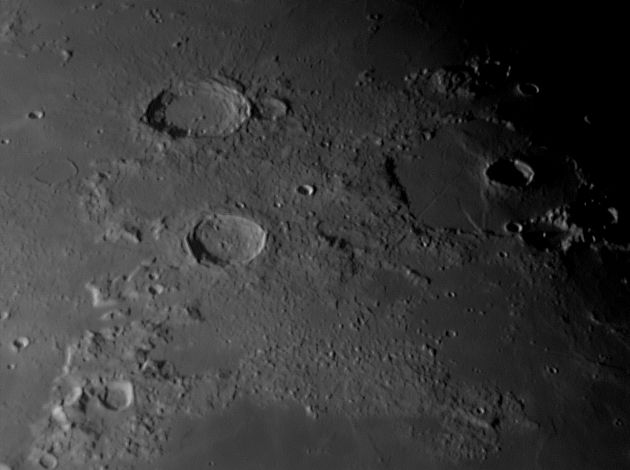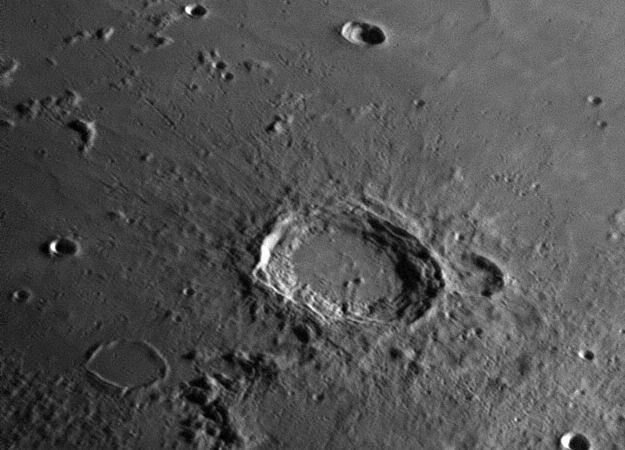Aristoteles and Eudoxus 
Move your mouse over the picture to see the names of the various features.
Aristoteles and Eudoxus are an interesting pair of craters to the north of Mare Serenitatis.
They are comparatively young,
Aristoteles being between 1,000 and 3,000 million years, and Eudoxus less than 1,000 million years old. Craters of this size would be expected to have large central mountains but both have only a few low hills. The walls are also not typical of craters this size. Aristoteles is also interesting as one of few examples of a large crater supported by a smaller one, in this case Mitchell which is said be the older of the two. However, looking at the second picture below, I wonder why Mitchell was not destroyed by the impact that made Aristoteles.

|
A wide-angle pictures of both craters and showing the rugged area around them. Lacus Mortis, despite its name, is a large crater, 155 Km in diameter, and contains Burg (41 Km) entirely within it. Criss-crossing the floor of the lacus are several rimae which take their name from Burg.
The scale markers are approximately 100 Km north and east.
The picture was taken with a ToUcam attached to my LX200 on 23rd September 2005 at 01:58 UT, when the Moon was 20.1 days old.
Lunar Phase: 295.3°
Colongitude: 147.8°
Date and Time: 23rd September 2005 at 01:58 UT
Camera: ToUcam 740K
Telescope: LX200 with IR-pass filter
Capture: K3CCDTools. High gamma, 1/25", 0% gain, 419 frames
Processing: Registax. 72 frames stacked. Wavelet 1 = 10
|

|
A narrower-angle pictures of Aristoteles. At the time the Sun was only about 17° above the lunar horizon so the short shadows on the eastern side of Aristoteles show how gentle the inner slopes are. The lighting does, however, show nicely the ejecta blanket across Mare Frigoris to the north-west. I have included the name of the isolated mountain, Sheepshanks η, although the name is now obsolete and therefore unofficial.
The scale markers are approximately 50 Km north and east.
The picture was taken with a DMK camera attached to my LX200 with X2 SLR lens on 10th April 2011 at 20:24 UT, when the Moon was 6.7 days old.
Lunar Phase: 97.9°
Colongitude: 359.7°
Date and Time: 10th April 2011 at 20:24 UT
Camera: DMK 21AF04
Telescope: LX200 with IR-pass filter
Capture: ICCapture. Gamma 10, 1/77", gain 1023, 3410 frames
Processing: Registax6. 20 alignment points, 100 frames/point stacked. Gaussian wavelet 1 (0.1, 0.07) = 100, wavelet 2 (0.15, 0.1) = 100, wavelet 3 (0.44, 0.1) = 100
|
Home Back to NE Quadrant

